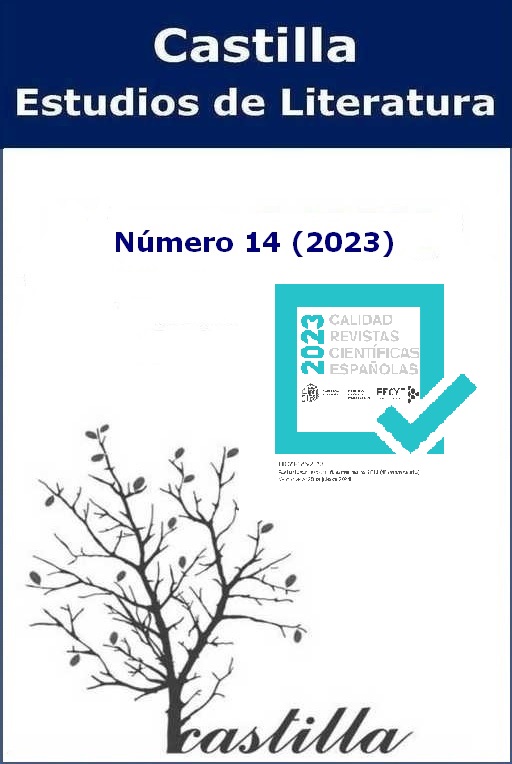Metaphor of hell on the northern Mexico border
DOI:
https://doi.org/10.24197/cel.14.2023.549-578Keywords:
border, violence, Mexico, northern literature, desert narrative, hellAbstract
The northern border of Mexico is seen by Mexican writers as an abyss through which beings from the underworld pass. These are the pateros and polleros who cross the undocumented to the other side of the border, immigration agents from USA, Americans searching for unbridled fun, murderers and thugs, and even the commons inhabitants of the north. The border, as it‘s a place of passage, brings violence and insecurity that make it a hell for everyone who approaches to the border. This Avern is formed by the borders that separate people, by the cities hosting, and by the natural landscapes, such as the desert, the river and, even, the mountains, that don’t protect anyone.
This paper analyzes the use of the metaphor of hell to describe the violence that is generated around the border between Mexico and United States.
Downloads
References
Almazán, Alejandro (2009). Entre perros. México D.F.: Mondadori.
Anzaldúa, Gloria (1987). Borderlands/ La Frontera: The New Mestiza. San Francisco: Aunt Lute Book Company.
Belausteguigoitia, Marisa (2009). “Frontera”, en Mónica Szurmuk y Robert Mckee Irwin (coord.), Diccionario de estudios culturales latinoamericanos. México: Siglo XXI, pp. 106- 111.
Briscoe, Iván, y Matute Rodríguez, Arturo (2018). “México: Trump y el tapón migratorio”. Política exterior, 32(184). 92-99.
Camacho Delgado, José Manuel (2016). “Fronteras con espinas: literatura, violencia y narcotráfico”. Anuario de Estudios Americanos, 73(2), 415-424.
Cuevas Velasco, Norma Angélica (2017). “Narrativa centroamericana: frontera, violencia y exilio. Apuntes para una crónica de la corrupción”. Valenciana, 10(20), 87-112. DOI: https://doi.org/10.15174/rv.v0i20.292.
Herbert, Julián (2006). “El norte como fantasma”. Literal y Hermanocerdo, https://yonkeherbert.blogspot.com/2010/02/el-norte-como-fantasma.html [15/01/2023].
Maristain, Mónica. “La última entrevista de Roberto Bolaño: Estrella distante”. Página 12 (2003): https://www.pagina12.com.ar/diario/suplementos/radar/9-843-2003-07-19.html [15/01/2023].
Mbembe, Achille (2011). Necropolítica seguido de Sobre el gobierno privado directo. Santa Cruz de Tenerife: Melusina.
Mendoza, Élmer. (2016). Besar al detective. Barcelona: Penguin Random House Grupo Editorial.
Páez Varela, Alejandro (2009). Corazón de Kaláshnikov. El amor en los tiempos del narco. México, D.F.: Editorial Planeta Mexicana.
Parra, Eduardo Antonio. “Notas sobre la nueva narrativa del norte”. La jornada (2001), https://www.jornada.com.mx/2001/05/27/sem-parra.htm [15/01/2023].
Parra, Eduardo Antonio (2002). Nostalgia de la sombra. México D.F.: Editorial Planeta Mexicana.
Salinas, Gilda (2013). La narcocumbre. México D.F.: Alfaguara.
Tabuenca Córdoba, María Socorro (1997). “Aproximaciones críticas sobre las literaturas de las fronteras”. Frontera Norte, 9(8). 85-110
Tabuenca Córdoba, María Socorro (2020). “Wet minds y colonialismo intelectual: saberes de aquí y allá”. iMex Revista, 9(17). 109-132. DOI: https://doi.org/10.23692/iMex.17.8.
Torres Sauchet, Martín (2011). “La ciudad fronteriza de Luis Humberto Crosthwaite en Estrella de la calle sexta e Instrucciones para cruzar la frontera”. Connotas. Revista de crítica y teoría literarias. 12 (2011): 9-26, https://connotas.unison.mx/index.php/critlit/article/view/137/105 [15/01/2023].
Valenzuela Arce, José Manuel (2000). “Norteños ayankados. Discursos y representaciones de la frontera”. Comunicación y sociedad. 37-57.
Valenzuela Arce, José Manuel (2019). Trazos de sangre y fuego. Bionecropolítica y juvenicidio en América Latina. Bielefeld: Bielefeld University Press.
Vilanova, Nuria (2017). “Colonialismos, poscolonialismos y poderes hegemónicos en la frontera norte de México: arte, literatura y resistencia cultural”. Kamchatka. Revista de análisis cultural, 9: 189-206.
Downloads
Published
Issue
Section
License
Copyright (c) 2023 Esther de Orduña Fernández

This work is licensed under a Creative Commons Attribution 4.0 International License.
This journal enables free and immediate access to its content to foster global knowledge.

The articles published at Castilla. Estudios de Literatura will have a Creative Commons Attribution 4.0 International License (CC BY 4.0).
The authors continue as owners of their works, and can republish their articles in another medium without having to request authorization, as long as they indicate that the work was originally published in Castilla. Estudios de Literatura.



